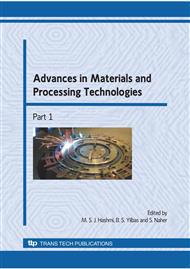p.1143
p.1151
p.1160
p.1165
p.1173
p.1182
p.1190
p.1197
p.1205
Microstructural and Mechanical Characterization of Friction Stir Welded- 1050 Aluminium Alloy
Abstract:
Friction stir welding (FSW) is a fairly recent technique that utilizes a non-consumable rotating welding tool to generate frictional heat and plastic deformation at the welding location in the continuously-fed work piece. In the present investigation this welding process is applied to join 1050 cold-rolled aluminium plates. The effects of varying the welding parameters namely welding speed [56, 90 and 140 mm/min] and tool rotational speed [850 and 1070 rpm] on the mechanical and microstructural properties were studied. Vickers micro hardness results across the weldment showed that the weld nugget hardness is dependant upon the welding speed and the tool rotational speed. Increasing the welding speed at 850 rpm reduced the hardness at the weld nugget, whereas, at 1070 rpm the weld nugget hardness merely did not change. However, the hardness achieved at 850 rpm was constantly higher than that achieved with 1070 rpm irrespective to welding speeds. In the same fashion, the yield and ultimate strengths of the joints were influenced by varying the welding parameters. Increasing the welding speed at 850 rpm reduced both strengths whereas; at 1070 rpm they were almost unchanged. Microstructural study showed that the weld region is composed of unaffected base metal and the stir zoned [weld nugget] which is characterised by a fine equiaxed grain structure. Increasing the welding speed at constant tool rotational speed has caused a slight refinement in the weld nugget's grain size, whereas, decreasing the rotational speed has also led to weld nugget grain refinement.
Info:
Periodical:
Pages:
1173-1181
Citation:
Online since:
December 2009
Authors:
Price:
Сopyright:
© 2010 Trans Tech Publications Ltd. All Rights Reserved
Share:
Citation:


